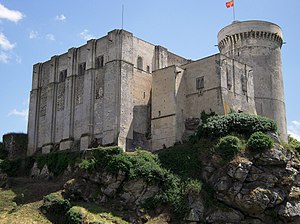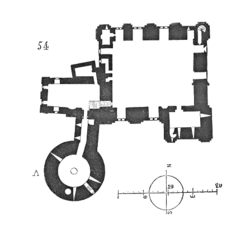Château de Falaise
| Château de Falaise Falaise Castle |
|
|---|---|
| Falaise, Normandy, France | |

The keeps
|
|
 |
|
| Coordinates | 48°53′36″N 0°12′14″W / 48.8932°N 0.2039°W |
| Site information | |
| Owner | City of Falaise |
| Controlled by | Dukes of Normandy |
| Condition | Renovated |
| Site history | |
| Materials | Limestone |
The Château de Falaise is a castle located in the south of the commune of Falaise ("cliff" in French) in the Calvados département of Calvados, in the region of Normandy, France. William the Conqueror, the son of Duke Robert of Normandy, was born at an earlier castle on the same site in about 1028. William went on to conquer England and become king and possession of the castle descended through his heirs until the 13th century when it was captured by King Philip II of France.
Possession of the castle changed hands several times during the Hundred Years' War. The castle was deserted during the 17th century. Since 1840 it has been protected as a monument historique.
On the death of Richard II, Duke of Normandy, in August 1026 his son (also called Richard) succeeded to the duchy. The inheritance however was disputed by Richard III's younger brother, Robert. Not content with his inheritance of the town of Exmes and its surrounding area, Robert rebelled and took up arms against his brother and he captured the castle of Falaise. Richard besieged the castle and forced Robert to submit to him, however the duke died from unknown causes in 1027 and was succeeded by his brother. Robert fathered an illegitimate son by a woman named Herleva, who was from the town of Falaise and the daughter of a chamberlain. The child, William, was born in about 1028.
The castle (12th–13th century), which overlooks the town from a high crag, was formerly the seat of the Dukes of Normandy. The construction was started on the site of an earlier castle in 1123 by Henry I of England, with the "large keep" (grand donjon). Later was added the "small keep" (petit donjon).
...
Wikipedia

